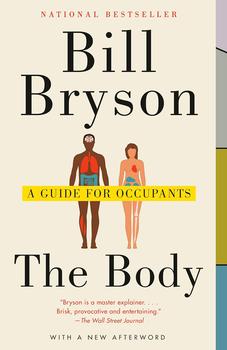Summary | Excerpt | Reviews | Beyond the Book | Readalikes | Genres & Themes | Author Bio

Critics' Opinion:
Readers' Opinion:
First Published:
Oct 2019, 464 pages
Paperback:
Jan 2021, 464 pages
 Book Reviewed by:
Book Reviewed by:
Kim Kovacs
Buy This Book
Hemoglobin has one strange and dangerous quirk: it vastly prefers carbon monoxide to oxygen. If carbon monoxide is present, hemoglobin will pack it in, like passengers on a rush-hour train, and leave the oxygen on the platform. That's why it kills people. (About 430 of them a year in the United States unintentionally, and a similar number by suicide.)
Each red corpuscle survives for about four months, which is pretty good going considering what a jostling and busy existence it leads. Each will be shot around your body about 150,000 times, logging a hundred miles or so of travel before it is too battered to go on. Then these corpuscles are collected by scavenger cells and sent to the spleen for disposal. You discard about a hundred billion red blood cells every day. They are a big component of what makes your stools brown. (Bilirubin, a by-product of the same process, is responsible for the golden glow of urine as well as the yellow blush of fading bruises.)
White blood cells (or leukocytes) are vital for fighting off infections. In fact, they are so important that we will treat them separately in chapter 12, on the immune system. For the moment, it is enough to know that they are much less numerous than their red siblings. You have seven hundred times as many red blood cells as white ones, which constitute less than 1 percent of the total.*
Platelets (or thrombocytes), the final part of the blood quartet, also account for less than 1 percent of blood's volume. Platelets were for a long time a mystery to anatomists. They were first seen under a microscope in 1841 by a British anatomist named George Gulliver, but they weren't named or properly understood until 1910 when James Homer Wright, chief pathologist at the Massachusetts General Hospital in Boston, deduced their central role in clotting. Clotting is a tricky business. The blood must be perpetually on alert to clot at a moment's notice, but equally mustn't clot unnecessarily. As soon as a bleed starts, millions of platelets begin to cluster around the wound and are joined by similarly vast numbers of proteins, which deposit a material called fibrin. This agglomerates with the platelets to make a plug. To try to avoid errors, no fewer than twelve fail- safe mechanisms are built into the process. Clotting doesn't work in the principal arteries, because the flow of blood is too fierce; any clot would be swept away, which is why major bleeds must be stopped with the pressure of a tourniquet. In severe bleeding, the body does all it can to keep blood flowing to the vital organs and diverts it away from secondary outposts like muscles and surface tissues. That's why patients who are bleeding heavily turn a cadaverous white and are cold to the touch. Platelets live for only about a week, so must be constantly replenished. In the last decade or so, scientists have realized that platelets do more than just manage the clotting process. They also play important roles in immune response and in tissue regeneration.
For the longest time, almost nothing was known about the purpose of blood beyond that it was somehow vital to life. The prevailing theory, dating since the time of the venerable but frequently mistaken Greek physician Galen (ca. 129—ca. 210), was that blood was manufactured continuously in the liver and used up by the body as fast as it was made. As you will doubtless recall from your school days, the English physician William Harvey (1578–1657) realized that blood is not endlessly consumed, but rather circulates in a closed system. In a landmark work called Exercitatio anatomica de motu cordis et sanguinis in animalibus (On the Motion of the Heart and Blood in Animals), Harvey outlined all the details of how the heart and circulatory system work, in more or less the terms we understand today. When I was a schoolboy, this was always presented as one of those eureka moments that changed the world. In fact, in Harvey's day the theory was almost universally ridiculed and rejected. Nearly all Harvey's peers thought him "crack- brained," in the words of the diarist John Aubrey. Harvey was abandoned by most of his clients and died a bitter man.
Excerpted from The Body by Bill Bryson. Copyright © 2019 by Bill Bryson. All rights reserved. No part of this excerpt may be reproduced or reprinted without permission in writing from the publisher.





The House on Biscayne Bay
by Chanel Cleeton
As death stalks a gothic mansion in Miami, the lives of two women intertwine as the past and present collide.

The Flower Sisters
by Michelle Collins Anderson
From the new Fannie Flagg of the Ozarks, a richly-woven story of family, forgiveness, and reinvention.

The Funeral Cryer by Wenyan Lu
Debut novelist Wenyan Lu brings us this witty yet profound story about one woman's midlife reawakening in contemporary rural China.
Your guide toexceptional books
BookBrowse seeks out and recommends the best in contemporary fiction and nonfiction—books that not only engage and entertain but also deepen our understanding of ourselves and the world around us.